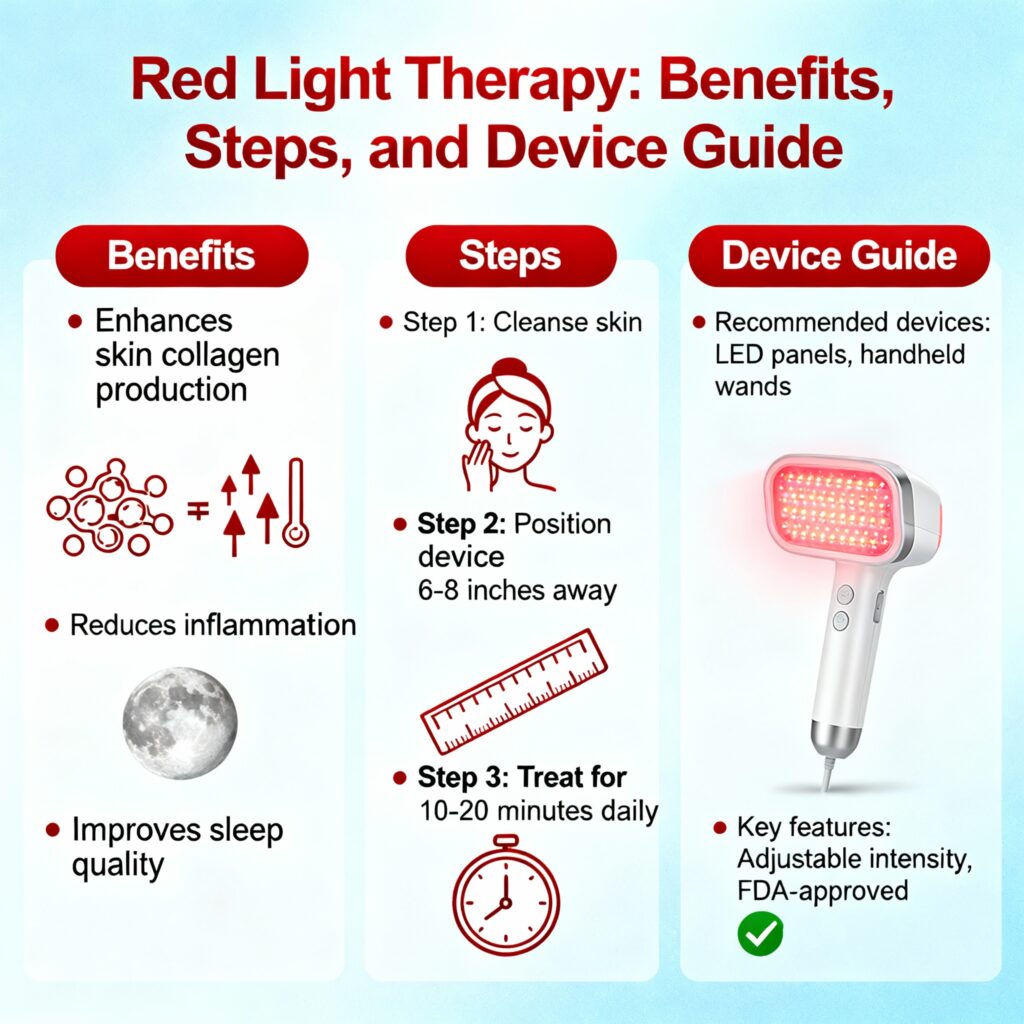Ever feel like you’re constantly chasing the next health hack? Cold showers, intermittent fasting, fancy supplements—we’ve all been there. But what if I told you one of the most powerful wellness tools doesn’t require you to swallow anything or freeze your butt off?
Welcome to the world of red light therapy.
It sounds almost too simple, right? Just stand in front of some red lights and suddenly your skin looks better, you recover faster, and you have more energy. But here’s the thing—there’s actually solid science behind it.
And the best part? You don’t need to book expensive spa appointments anymore. At-home red light therapy devices have made this technology accessible to anyone serious about optimizing their health.
Let’s dive into everything you need to know about using red light therapy at home, from the science to the best devices to the exact protocols that actually work.
What Exactly Is Red Light Therapy?
Red light therapy (RLT) goes by a few names—photobiomodulation, low-level light therapy, LED therapy. But they all mean the same thing: using specific wavelengths of light to trigger beneficial changes in your body.
Unlike the UV rays from the sun that damage your skin, red light therapy uses natural red and near-infrared wavelengths (usually between 600-900 nanometers). These wavelengths are completely safe and actually therapeutic.
Here’s where it gets interesting.
When these light waves penetrate your skin, they’re absorbed by your mitochondria—the tiny power plants inside every cell in your body. Research from Stanford Medicine shows that this light literally charges up your cells, helping them produce more ATP (the energy molecule your body runs on).
Think of it like plugging your phone into a charger. Your cells get a direct energy boost, and that’s when the magic happens.
The Real Benefits of Red Light Therapy (Backed by Science)
Okay, so what can red light therapy actually do for you? Let’s break down the benefits that have real research behind them.
Supercharge Your Cellular Energy
This is the foundation of everything else. When your mitochondria work better, your entire body functions better.
You might notice more physical energy throughout the day. Your workouts might feel easier. Your brain might feel sharper. It’s not a placebo—it’s your cells literally producing more fuel.
Turn Back the Clock on Your Skin
This is probably the most visible benefit. Red light therapy has been shown to seriously improve skin quality.
According to the Cleveland Clinic, red light stimulates collagen production—that’s the protein that keeps your skin firm and youthful. It also increases blood flow to your skin and reduces inflammation.
What does that mean for you?
Fewer wrinkles and fine lines. Better skin texture. Reduced acne and redness. Fading of scars and sun damage. Basically, it’s like having a professional skin treatment in your own home.
And unlike harsh chemical peels or invasive procedures, red light therapy is gentle and natural.
Recover Faster from Workouts
If you’re into fitness, this is a game-changer.
Red and near-infrared light penetrates deep into your muscles and joints. It reduces inflammation, speeds up tissue repair, and helps flush out metabolic waste.
Studies on photobiomodulation in muscle tissue have shown that using red light before or after exercise can improve performance and cut down recovery time.
Translation? Less soreness. Faster gains. More time crushing your goals instead of hobbling around like a zombie.
Sleep Better and Fix Your Circadian Rhythm
We’re all drowning in blue light from our phones, laptops, and TVs. That blue light tells your brain it’s daytime, which messes with your melatonin production and ruins your sleep.
Red light is different. It doesn’t suppress melatonin the way blue light does.
Research on red light and sleep suggests that using red light in the evening is far less disruptive to your natural sleep-wake cycle. Some people even use it strategically to wind down before bed.
It’s not a magic sleep pill, but it’s a smart way to support your body’s natural rhythms.
Reduce Pain and Inflammation
Chronic pain is exhausting. Whether it’s joint pain, muscle aches, or old injuries that never quite healed, red light therapy can help.
The anti-inflammatory effects are well-documented. People use it for everything from arthritis to tendonitis to general muscle soreness.
It’s non-invasive, drug-free, and you can do it while watching Netflix. Hard to beat that.
How to Choose the Right At-Home Red Light Device
This is where it gets a little overwhelming. There are hundreds of devices out there, and they range from $50 handheld wands to $2,000 full-body panels.
So how do you choose?
First, think about your goals. Are you mainly focused on your face? Go with a mask. Want full-body benefits? You’ll need a panel. Targeting specific areas like a sore shoulder? A handheld wand might be perfect.
Here’s a quick breakdown of the main types:
Full-Body Panels
These are the big boys. They’re usually mounted on a stand and cover a large area—sometimes your entire torso.
Pros: Maximum power, treat multiple areas at once, great for overall wellness and recovery.
Cons: Expensive (often $500-$2000+), take up space, not very portable.
Best for: Serious biohackers, athletes, anyone wanting full-body mitochondrial support.
Popular brands include Joovv, Mito Red Light, and PlatinumLED. These are the ones you’ll see in biohacking forums and high-performance gyms.
LED Face Masks
These fit over your face like a spa mask and deliver red (and sometimes blue) light directly to your skin.
Pros: Hands-free, easy to use, great for skin benefits, relatively affordable.
Cons: Only treats your face, power can vary a lot between brands.
Best for: Anti-aging, acne treatment, skin rejuvenation.
Wirecutter’s testing found that masks like the Omnilux Contour and Shark CryoGlow deliver solid results without breaking the bank.
Handheld Wands
These are small, portable devices you move around your face or body.
Pros: Affordable (often under $200), portable, good for targeting specific spots.
Cons: Requires manual effort, lower power than panels, takes longer to treat large areas.
Best for: Beginners, travelers, spot-treating wrinkles or scars.
The LightStim wand is a popular choice—it’s packed with LEDs and emits multiple wavelengths.
What to Look for in a Device
Don’t just buy the cheapest thing on Amazon. Here’s what actually matters:
Wavelengths: Look for devices that offer 660nm (red) and 850nm (near-infrared). These are the most researched and effective.
Power Output: This is measured in mW/cm² (milliwatts per square centimeter). You want at least 40-100 mW/cm² for good results.
LED Count: More LEDs generally mean better coverage and power.
FDA Clearance: While this mainly confirms safety, it’s a good sign the company is legit.
Your At-Home Red Light Therapy Protocol
Alright, you’ve got your device. Now what?
The key to seeing real results is consistency. You can’t just use it once and expect miracles. Think of it like going to the gym—regular sessions add up over time.
General Guidelines
Start slow. If you’re new to this, begin with 5-10 minute sessions and see how your body responds. You can gradually work up to 15-20 minutes.
Distance matters. Most devices work best when you’re 6-18 inches away. Check your device’s manual for specific recommendations.
Consistency is everything. Aim for at least 3-5 sessions per week. Daily use is even better and totally safe.
Protect your eyes. The LEDs are bright. Don’t stare directly at them. Most masks cover your eyes, but if you’re using a panel, close your eyes or wear the protective goggles that come with it.
Specific Protocols by Goal
For Skin Rejuvenation:
- 10-15 minutes per session
- 3-5 times per week
- 6-12 inches from your face
- Best time: Morning or evening as part of your skincare routine
- Results: Expect to see improvements in 4-8 weeks
For Muscle Recovery:
- 10-20 minutes on the affected area
- Daily after workouts (or 5x per week)
- 6-18 inches from your body
- Best time: Right after training
- Results: Reduced soreness within days, better long-term recovery
For Better Sleep:
- 10-15 minutes
- Daily in the evening (but not right before bed)
- 12-24 inches from a panel
- Best time: 1-2 hours before bedtime
- Results: May notice better sleep quality within 1-2 weeks
For Pain and Inflammation:
- 15-20 minutes on the painful area
- Daily until symptoms improve, then 3-5x per week
- 6-12 inches from the area
- Best time: Whenever pain is worst
- Results: Some people feel relief within days, others need a few weeks
Common Mistakes to Avoid
Using it too close or too far. Distance affects how much light actually reaches your cells. Follow the manufacturer’s guidelines.
Inconsistent use. Using it randomly won’t give you results. Set a schedule and stick to it.
Expecting overnight miracles. This isn’t magic. It’s biology. Give it at least 4-6 weeks of consistent use before judging results.
Overdoing it. More isn’t always better. Stick to the recommended session times. There’s a sweet spot, and going way over it can actually reduce effectiveness.
The Bottom Line
Red light therapy isn’t some woo-woo wellness trend. It’s a legitimate biohacking tool with real science behind it.
It works by charging up your mitochondria, which then triggers a cascade of beneficial effects throughout your body. Better skin. Faster recovery. More energy. Better sleep. Less pain.
And now that high-quality at-home devices are widely available, you don’t need to spend hundreds on spa treatments. You can get clinical-grade results in your own home.
Is it a miracle cure? No. But is it a powerful, safe, and effective way to support your body’s natural healing and optimization processes? Absolutely.
If you’re serious about biohacking and optimizing your health, red light therapy deserves a spot in your routine.
Start with a device that fits your budget and goals. Use it consistently. Protect your eyes. And give it time.
Your cells—and your future self—will thank you.
FAQ: Your Red Light Therapy Questions Answered
How long before I see results?
It depends on what you’re treating. Some people notice better energy and reduced inflammation within a few sessions. Skin improvements usually take 4-12 weeks of consistent use. Hair regrowth can take 3-6 months.
Is it actually safe?
Yes, when used properly. Red light therapy is non-invasive, doesn’t use UV rays, and has minimal side effects. The main safety rule is to protect your eyes from the bright LEDs. Don’t stare directly at the lights.
Can I use it every day?
Absolutely. Daily use is safe and often recommended. Just stick to the recommended session times (usually 10-20 minutes).
Will it help me lose weight?
Probably not. While some small studies have explored this, there’s no strong evidence that red light therapy is effective for weight loss. Stick with diet and exercise for that.
Do I need a prescription?
Nope. At-home red light therapy devices are available over the counter. No prescription needed.
What’s the difference between red and near-infrared light?
Red light (around 660nm) is visible and penetrates the skin’s surface layers. Near-infrared (around 850nm) is invisible to the eye and penetrates deeper into muscles and joints. The best devices offer both.
Can I use it with other skincare products?
Yes! In fact, some people find that red light therapy enhances the absorption of serums and moisturizers. Just make sure your skin is clean before your session.
How much should I spend?
It depends on your goals. You can get a decent handheld wand for $100-250. Quality face masks run $200-400. Full-body panels range from $500-2000+. Don’t go for the cheapest option—quality matters.
Sources & Further Reading:
- Stanford Medicine: Red Light Therapy – What the Science Says
- Cleveland Clinic: Red Light Therapy Benefits and Uses
- NCBI: Photobiomodulation – Underlying Mechanisms and Clinical Applications
- NCBI: Photobiomodulation in Human Muscle Tissue
- NCBI: Effects of Red Light on Sleep and Mood
- Wirecutter: Best Red Light Therapy Devices


